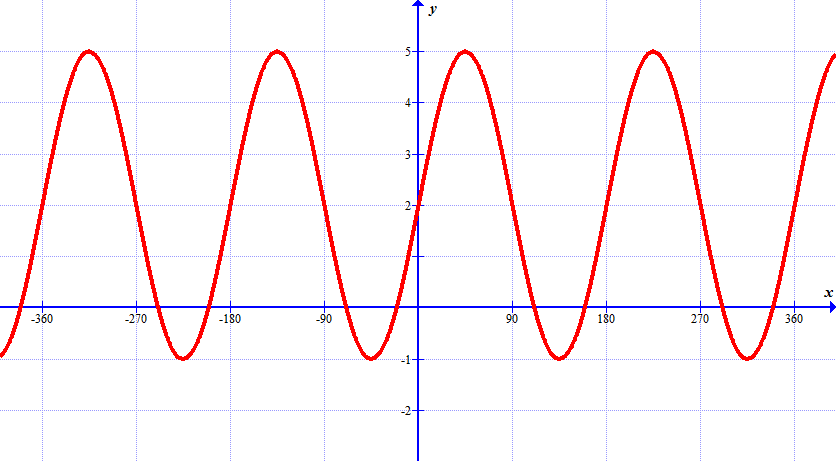-
Draw the graph of the function and determine the following properties:
(a) find the minimum value and the maximum value,
(b) find the period.
Solutions:
(a) min. value: , max. value: ;
(b) period:
-
Draw the graph of the function and determine the following properties:
(a) find the minimum value and the maximum value,
(b) find the period.
Solutions:
(a) min. value: , max. value: ;
(b) period:
-
?
?
Coefficients in the equation have the meaning:
amplitude,
vertical shift
Principal axis has the equation: .
Draw the graph of the function and determine the following properties:
(a) find the amplitude,
(b) find the principal axis,
(c) find the minimum value and the maximum value,
(d) find the period.
Solutions:
(a) amplitude: ;
(b) principal axis: ;
(c) min. value: , max. value: ;
(d) period:
-
?
?
Coefficient in the equation has the meaning:
horizontal shrink
Period of the function is .
Draw the graph of the function and determine the following properties:
(a) find the minimum value and the maximum value,
(b) find the period.
Solutions:
(a) min. value: , max. value: ;
(b) period:
-
?
?
Coefficient in the equation has the meaning:
horizontal shift
Draw the graph of the function and determine the following properties:
(a) find the minimum value and the maximum value,
(b) find the period.
Solutions:
(a) min. value: , max. value: ;
(b) period:
-
Draw the graph of the function and determine the following properties:
(a) find the minimum value and the maximum value,
(b) find the period.
Solutions:
(a) min. value: , max. value: ;
(b) period:
-
Draw the graph of the function and determine the following properties:
(a) find the minimum value and the maximum value,
(b) find the period.
Solutions:
(a) min. value: , max. value: ;
(b) period:
-
Draw the graph of the function and determine the following properties:
(a) find the principal axis,
(b) write down the range,
(c) find all minima for .
Solutions:
(a) principal axis: ;
(b) range: ;
(c) minimum at:
-
Draw the graph of the function and determine the following properties:
(a) find all -intercepts for ,
(b) write down minima and maxima for .
Solutions:
(a) -intercepts: ;
(b) min.: ,
max.:
-
Draw the graph of the function and determine the following properties:
(a) find -intercept,
(b) find all -intercepts on ,
(c) write down the greatest and the least value, and state the smallest non-negative
value of for which they occur.
Solutions:
(a) -intercept: ;
(b) -intercepts: ;
(c) min. value occurs at ,
max. value occurs at
-
Graph of a function is drawn in the picture below.
(a) find the principal axis, amplitude and period,
(b) write the function in the form

Solutions:
(a) principal axis: , amplitude: , period ;
(b)
-
Graph of a function is drawn in the picture below.
(a) find the principal axis, amplitude and period,
(b) write the function in the form

Solutions:
(a) principal axis: , amplitude: , period ;
(b)
-
Use your GDC to draw the graph of the function
. This function can be written in the form
. Find the values of the constants and .
Solutions:
;
-
Use your GDC to draw the graph of the function
. Then write this function in the form
.
Solutions:
(Use the GDC to verify your solution.)
-
Draw the graph of the function and determine the following properties:
(a) find the minimum value and the maximum value,
(b) find the period.
Solutions:
(a) min. value: , max. value: ;
(b) period: radians
-
Draw the graph of the function and determine the following properties:
(a) find the minimum value and the maximum value,
(b) find the period.
Solutions:
(a) min. value: , max. value: ;
(b) period: radians
-
Draw the graph of the function and determine the following properties:
(a) find the principal axis,
(b) find the minimum value and the maximum value,
(c) find the period.
Solutions:
(a) principal axis: ;
(b) min. value: , max. value: ;
(c) period:
-
Draw the graph of the function and determine the following properties:
(a) find the domain and range,
(b) find the period,
(c) write down minima and maxima.
Solutions:
(a) domain: , range: ;
(b) period: ;
(c) min.: , max.:
-
Draw the graph of the function and determine the following properties:
(a) find all -intercepts on ,
(b) write down minima and maxima on .
Solutions:
(a) -intercepts: ;
(b) min.: ,
max.:
-
Draw the graph of the function and determine the following properties:
(a) find -intercept,
(b) find all -intercepts on ,
(c) write down the greatest and the least value, and state the smallest non-negative
value of for which they occur.
Solutions:
(a) -intercept: ;
(b) -intercepts: ;
(c) min. value occurs at ,
max. value occurs at



